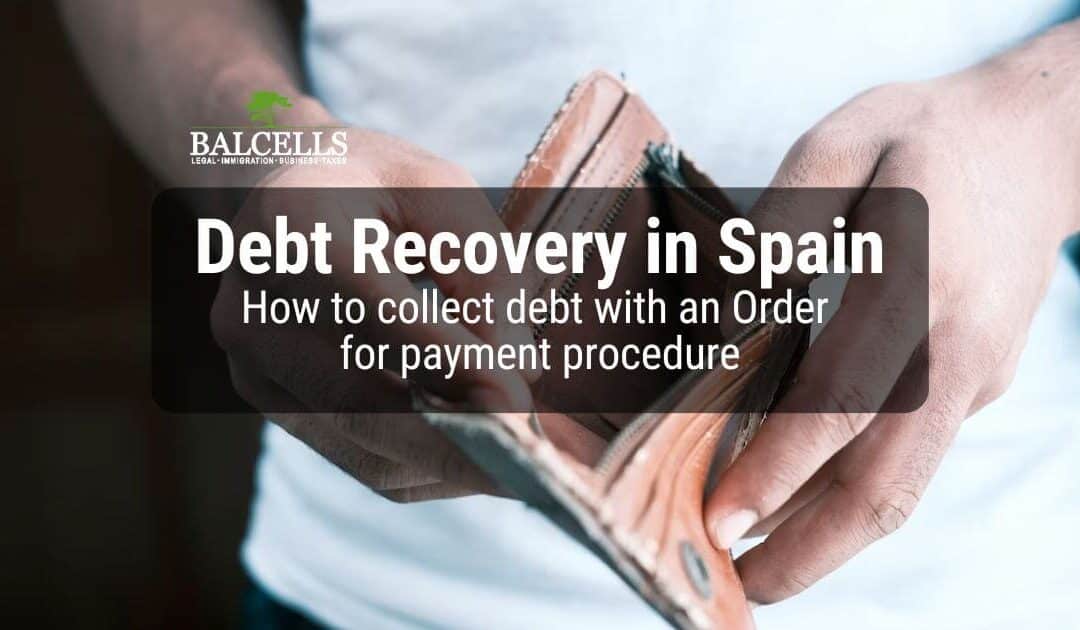If a supplier, customer, or tenant owes you money and you would like to know how to recover your debts… this article is for you. Below we analyze everything you need to know about the legal procedure that will allow you to claim any type of invoice or credit, known as the order for payment procedure. We will explore what requirements the debt must meet in order to be claimed, how the process works step by step, what are the timings, and other tips that will be very useful to ensure a successful process.
This legal procedure is faster and more agile than you think, so if you want to find out how to claim your debts in Spain… Keep reading!
How long can a debt be chased in Spain?
Before diving into the exact procedure for claiming unpaid debt and understanding how it works, it is important to take into account how long can a debt be chased in the Spanish territory, but also the minimum time that must pass before the claim can be initiated.
In the case of perishable goods, the amount must be paid within 30 days of the issuance of the invoice. In other cases, the debt can be considered unpaid and the claim procedure can be initiated after 60 days.
This is so, obviously, unless something different has been agreed between the parties contractually. If that is the case, these timings could be longer (or shorter).
But we must also consider the prescription period of the unpaid invoice, meaning the amount of time you have to claim that debt.
In this case, this amount of time is 5 years. If that time has elapsed and you have not initiated the claim, you would no longer be able to recover your money.
But if you are within the established time, in order to recover your money you will have to follow the legal procedure known as the order payment process (or “procedimiento monitorio” in Spanish), which may require a trial.
How does this process work? Let’s take a look.
What is an order for payment procedure?
An order for payment procedure is a legal process that allows you to claim and recover monetary amounts that a supplier or customer owes you, quickly and efficiently.
This procedure, called “monitorio” in Spanish, is very popular and is used by many due to its advantages.
If there is a client who does not pay one (or several) invoices, if the tenant of your apartment has not paid the rent for months, or if you find yourself in any other similar situation in which you are owed money, you should initiate an order for payment procedure with the Spanish authorities to be able to recover and claim such amounts.
This is a fast and really agile process, since it will only be necessary to provide the judge with proof of the debt in a liquid and enforceable form (e.g. invoice, delivery note, credit, or other document that proves that the person owes us money).
And just with this, the process would begin.
One of its main advantages is that once initiated, if the debtor does not respond within the established period of time, it is automatically possible to recover the debt since this debtor will have to face the totality of the claimed amount with all its present and future assets.
What amount can be claimed with an order for payment?
Any amount owed can be claimed through an order for payment procedure. There is no minimum or maximum amount.
You simply need to provide proof that there is an amount owed and this process can be initiated without any problem.
However, as we will see below, the process will be different depending on the total amount owed.
Do I need an attorney to collect a debt?
One of the advantages of this procedure is that NO lawyer or attorney is needed up to a claim equivalent to €2,000.
Any higher amount will require these professionals.
Later in this article, we will analyze why the role of the lawyer is so important in this procedure (even if the amount is less than two thousand euros), and how this professional can help you to claim your debts.
Debt requirements to initiate the debt collection procedure
The LEC, or Ley de Enjuiciamiento Civil is the law that regulates the claim of debts through this procedure, and it does so between articles 812 and 818.
Since any citizen can initiate this legal process, the requirements are based on the conditions of the debt to be claimed.
Thus, it is this same law (the LEC) that defines the requirements that the debt must meet in order to be claimed through a payment order.
We find 4 characteristics that the claimed amount must meet:
- It must be enforceable, which means that the debtor must be obliged to pay it
- It must be liquid, which mainly means that it must be expressed numerically
- It must be determined, being able to define in a concrete and precise manner the amount owed
- It must be overdue, which means that the payment of the term has ended
As you can see, through an order for payment we can only claim specific monetary debts, leaving out claims in the form of uncompleted services or similar.
How do I collect debt in Spain?
As we have mentioned, this process is quite simple and consists of 3 essential parts or steps.
First, and before going to court, you will try to negotiate with the debtor the payment of the amount owed. It is always advisable to start in a friendly manner with different reminders before going to court.
However, many times this is not enough and the situation forces us to take other types of actions.
To do so, you must notify your intention and will to claim the debt through a “burofax” (a special type of legal document) to the debtor. In this document, you must highlight the attempt to contact repeatedly (failed), the amount owed and what justifies such amount, and a deadline for payment.
You will also establish the notice that if no response is received after this period (usually 15 days), a judicial proceeding will be initiated.
It is very important that this burofax includes all these elements, since later it will be one of the proofs to be issued to the judge.
At this point, the debtor has two options: to oppose or not to respond.
If the debtor does not respond, we will file an initial petition for a payment order procedure with the Lawyer of the Administration of Justice (the former Judicial Secretary).
The latter will review all the documentation provided as evidence and will grant the debtor 20 days to respond.
And here three things can happen:
The debtor responds and pays voluntarily
If the debtor responds positively by accepting the debt, the negotiation process is initiated.
In this case, this debtor would pay the amount owed (or the negotiated amount), and the Judicial Office will be notified in order to file the case.
The debtor does not respond
If the person who owes you money does not respond, an enforcement procedure is started, which means that a payment order is issued within a specific deadline attached.
If this deadline is not met and the debt is not paid, the creditor may request the judge to seize the debtor’s accounts or property (present or future) to satisfy the amount owed.
This is one of the main upsides of this debt claim process.
Why? Because the lack of response from the other party automatically implies your option to recover the money owed.
The debtor opposes
If the debtor responds within the deadline and opposes payment, the process is automatically interrupted.
This opposition can happen quite flexibly, as it just requires a simple notification to the judge from the counterpart, and although it is necessary to justify the reasons for opposition or non-conformity with the payment of the debt (or part of it), the process would be immediately stopped regardless of whether such justifications are valid or not.
What happens then?
There are two options:
- If the amount owed is less than 6.000€ a verbal proceeding will be initiated, which is a much faster process since all the evidence is executed at the verbal hearing directly and can be negotiated there and then
- If the amount to be claimed is higher than 6.000€, an ordinary trial is initiated, which is a much slower process since the judge requests the claim to be sent with all the evidence, and after a period of one month to answer, a hearing will be held
In both cases, it is necessary to have a lawyer and a solicitor.
How can I prove that I am actually owed debt?
So far we have seen what this procedure is and how it works. But one of the most important parts of it is to be able to prove that the debtor actually owes us money.
How to do it?
Below we analyze the 4 means of proof admitted in Spanish law to be able to demonstrate the link between both parties and to be able to effectively prove the obligation to pay the debt.
Thus, you will be able to use as proof:
- Any document that is signed or stamped by the debtor, that includes his trademark or any other similar sign (either online or physically)
- Through any document created by the creditor such as a delivery note, invoice, telegram, telefax, or certifications
- Commercial documents showing a long-standing relationship between creditor and debtor prior to the incurrence of the debt; to be submitted in conjunction with any document evidencing the debt
- Certifications of non-payment of common expenses of Communities of owners of urban properties
Again, one of the great advantages of this procedure is that any document of proof is valid. As long as you can prove the debt, you will be able to claim it directly.
Is it always advisable to initiate an order for payment procedure?
Because of the great advantages that this streamlined claim procedure offers, one might be tempted to initiate it in any case in which we have unpaid debts.
However, we must warn you that this is not always the best option.
As you have seen in the last section, if the debtor ends up opposing, you will go back to the starting point after weeks or months, and having spent time and effort on the whole process (in addition to all the discomfort that it may have generated) that you will not be able to recover.
That is why the most advisable thing to do when trying to recover a debt is to only initiate an order for payment if you expect that the client/debtor will not oppose and will pay.
Otherwise, it is best to go directly to the verbal or ordinary trial to avoid wasting time.
What happens if the debt occurs in another country? European order payment
It is also a common situation that the debtor is a company, institution, or individual located outside Spain (in any European Union country).
How does the process work with cross-border disputes?
There are two possible situations for cross-border disputes: the European Small Claims procedure and the European Order Payment.
In both cases, there is a procedure to follow, as long as both parties (creditor and debtor) are located within the European Union, excluding Denmark.
The European Small Claims Procedure
The European Small Claims procedure is the path to take if the debt is below €5,000. In this situation, it is not mandatory to involve a lawyer. The necessary thing to do is fill out Form A, which must be sent to the competent court. You can find all forms necessary for a European Small Claims procedure here.
Unless otherwise specified, this court is usually the one corresponding to the debtor’s domicile.
In this case, the debtor will have 30 days to respond, and in case he doesn’t, the assigned judge will have another 30 days to issue a judgment.
From this point on, the judge can:
- Issue an unfavorable or favorable judgment
- Ask for more information
- Carry out an oral hearing with the interested parties
The European Order Payment
A European Order Payment can only take place when no other type of procedure related to the debt has been initiated before.
The procedure is similar to the European Small Claims Procedure, as the corresponding Form A would also have to be filled out and sent to the competent court. Here you’ll find all forms necessary for a European Order Payment.
Afterwards, the completed form would be forwarded to the debtor, with an expected response from them within 30 days.
Upon receiving a response, the judge can then:
- Claim and ask for more information if she considers necessary
- Issue an unfavorable judgment and reject the creditor’s petition
- If a favorable judgment is issued and the debtor opposes, the process will be referred to national courts
- If the debtor does not respond after a favorable judgment, a writ of execution for the recovery of the debt would be issued
Debt recovery attorney. How can a lawyer help me recover my debt?
In most situations, having a lawyer to initiate your debt recovery order for payment procedure will be 100% necessary (more specifically if the debt exceeds €2,000).
But beyond the fact that it is legally necessary, it is highly recommended to have a lawyer in these cases for the following reasons:
- Even if the debt is less than 2.000€, in the case of a trial taking place you will be much better prepared (especially since the other party will have her lawyer)
- She will verify the nature and validity of the established contracts and will help you get valid evidence to be able to recover your debt
- Within an order payment process, the lawyer will be in contact with the debtor from the beginning and will not only take away the tedious burden of having to pursue her, but you will also be able to take advantage of her negotiation skills
- This last point means that in many cases your lawyer will be able to resolve the situation out of court, without the need to prolong the process in court
- A lawyer specialized in debt collection will guide you step by step and will take care of all the paperwork for you, avoiding that you miss any important deadlines and freeing you from the legal part (many times with important nuances that require knowing how the law works and the correct way to operate)
So, whether you have any questions about how this procedure works or if you would like our team of expert litigation lawyers to take care of everything, please contact us and we will get in touch as soon as possible.
Book a consultation with one of our lawyers and solve all your doubts:

At Balcells Group we have been foreigners effortlessly moving to Spain for over 11 years. We help expats from all around the world with their immigration, business, tax and legal needs; ensuring a legally safe and enjoyable transition to the Spanish territory. Our multilingual team understands the importance of adapting to the cultural and legal specificities of our international clients. We offer a comprehensive service that combines the expertise of several generations of lawyers with the innovation needed to address today’s legal challenges, always striving to simplify processes and ensure reliable, effective results.



